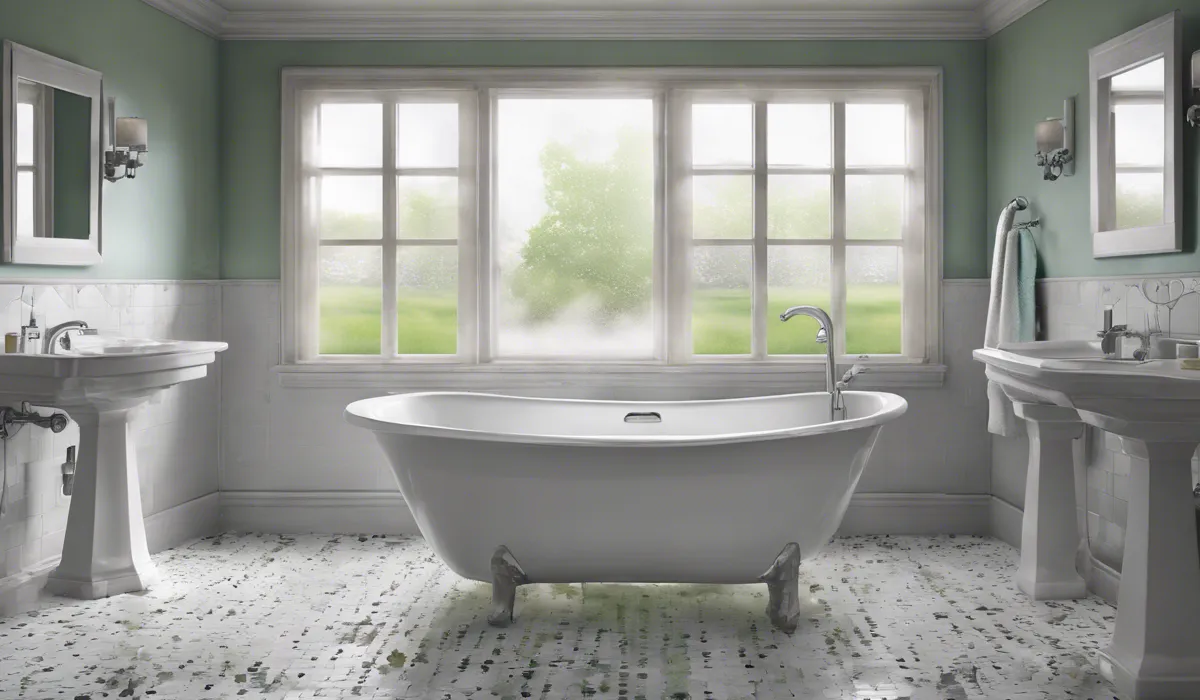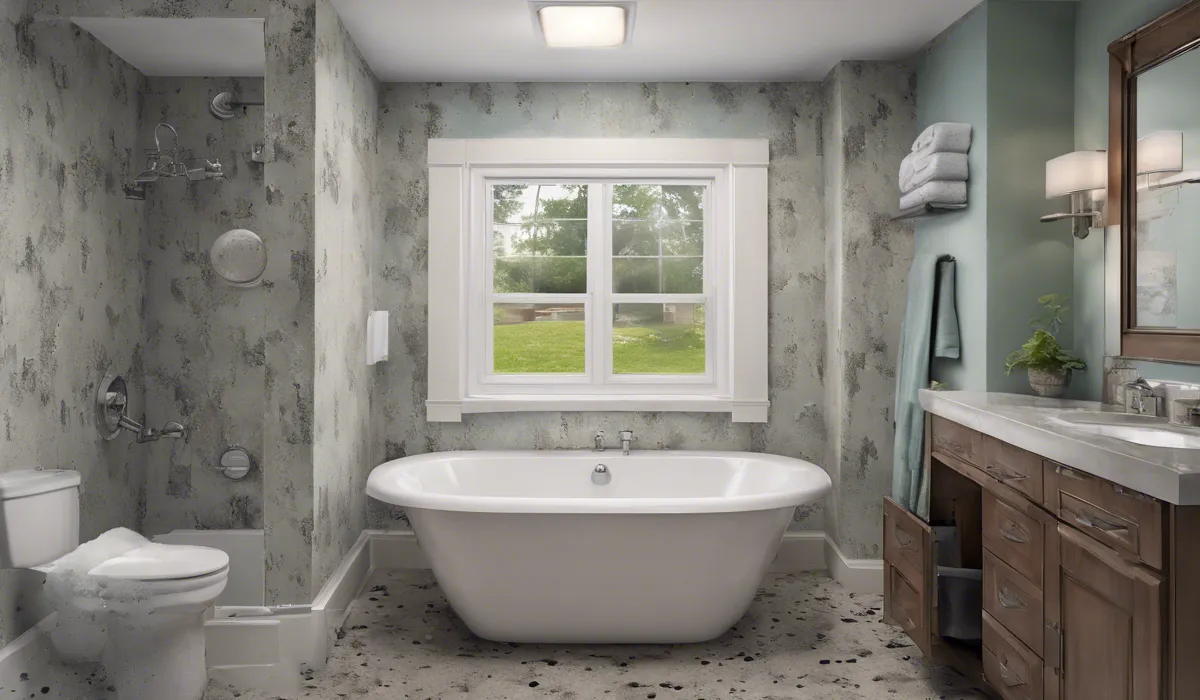To check for mold in your bathroom, inspect common areas like the shower, under the sink, and around the toilet. Look for black, green, or white growths. Notice musty odors and check for any water damage or persistent dampness, as these are indicators of potential mold presence.
Signs of Mold in the Bathroom

Visual Identification: Spotting Mold
One of the clearest signs that mold has invaded your bathroom is the appearance of black, green, or white spots.
These spots may appear on walls, ceilings, especially around any ceiling boxes, and within grout lines between tiles.
Mold can manifest in various shapes and colors, so it’s important to look out for any irregularities on surfaces where moisture is common.
Sniffing Out Mold
Mold often comes with a persistent earthy or musty smell. If you notice a continuous odd odor in your bathroom, it could be an indication of hidden mold.
Such smells are caused by microbial volatile organic compounds that mold releases as it grows, especially in areas where there is poor ventilation or trapped moisture.
Persistent Humidity: Moisture’s Role in Mold Growth
Bathrooms are naturally humid environments, but excessive moisture can create the perfect conditions for mold to flourish.
Persistent humidity, such as from a steamy shower, can seep into nooks and crannies, providing a haven for mold.
It’s key to control these moisture levels to prevent mold, for instance, by ensuring that exhaust fans are working properly or by opening windows to let out steam.
Water Damage: Indicators of Potential Mold
Water damage, like warped walls or peeling paint, might suggest the presence of mold behind surfaces. These signs can often be found near sources of water, such as sinks or bathtubs.
It’s essential to inspect for any toilet flange issues or leaks, as they can contribute to hidden mold growth behind tiles and wallboards.
Health Symptoms: Mold’s Impact on Well-being
Mold can be more than just a nuisance; it can affect your health. If you experience allergic reactions, such as sneezing, coughing, or respiratory issues, particularly when you’re in the bathroom, it may be a reaction to mold spores in the air.
Those with asthma or other respiratory conditions should be especially vigilant about the presence of mold in the home.
Steps for Inspecting Mold in the Bathroom

Prepare for Inspection: Safety First
Before inspecting for mold, it’s important to wear protective gear such as gloves and a mask.
This helps prevent the inhalation of mold spores, which can be harmful to your health. Safety goggles are also advisable to protect your eyes during the inspection process.
Check Common Areas: Where to Look
Start your mold inspection by looking at common areas where mold is likely to grow.
Check the shower curtains for any discoloration, inspect under the sink for leaks, examine around the toilet, and don’t forget to look at the ventilation fans.
These areas are prone to moisture and can often be the starting points for mold.
Look for Hidden Mold: Beyond the Surface
Mold doesn’t just grow in plain sight; it can also be hidden. Peek behind tiles, look under layers of paint, and consider the inside of wall cavities.
Use a flashlight to help spot any signs of mold in darker areas. If you’re unsure about removing fixtures or tiles, consider consulting with a professional.
Use Mold Testing Kits: DIY Analysis
If visual inspection isn’t conclusive, you might want to use a mold testing kit. These kits can help you collect samples from suspected areas.
Follow the instructions carefully to get an accurate reading. Once collected, the samples can be sent to a lab for analysis to determine the type of mold and the appropriate course of action.
Professional Inspection: Calling in the Experts
Sometimes, a DIY inspection isn’t enough. If you suspect a serious mold issue, it’s wise to hire a mold specialist.
Professionals have the tools and expertise to conduct a thorough examination and can access areas that might be difficult for you to reach.
They can also provide recommendations for remediation.
Mold Prevention and Remediation Tips

Adequate Ventilation: Keeping Air Moving
Proper ventilation is crucial in preventing mold growth. Use exhaust fans during and after showers to expel moist air, and open windows when weather permits.
This helps to reduce the overall moisture in the bathroom, making the environment less hospitable for mold.
Regular Cleaning: Mold’s Worst Enemy
To prevent mold buildup, incorporate routine cleaning into your schedule. This can include both natural solutions, like vinegar and baking soda, as well as chemical cleaning agents designed to target mold.
Pay particular attention to areas that frequently come into contact with water and are prone to dampness.
Control Humidity Levels: The Battle Against Moisture
Maintaining low humidity levels can help prevent mold. Consider using a dehumidifier to help regulate the moisture in the air.
Aim for a humidity level below 50% to create an environment that is less conducive to mold growth.
Fixing Leaks Promptly: Stopping Mold at the Source
Leaky faucets, pipes, and toilet flanges can lead to water accumulation, which in turn can encourage mold. Address any leaks as soon as they are detected.
This not only helps prevent mold but can also save on water costs and potential structural damage to your home.
When to Call Professionals: Expert Remediation?
If you find significant mold growth or if the area affected is large, it may be time to call in certified mold removal experts.
They are equipped to safely and effectively remove mold from your home, ensuring that it won’t pose a health risk to you or your family.
Remember, professional remediation is not only about removing mold but also about preventing its return.
FAQs About Checking for Mold in Bathroom
Where should I look for mold in my bathroom?
Inspect areas such as the shower, beneath the sink, around the toilet, and any other damp areas for signs of black, green, or white growths that may indicate mold.
What does mold look like in a bathroom?
Mold can appear as black, green, or white spots or growths on surfaces in your bathroom.
How can I tell if a musty odor in my bathroom is due to mold?
A musty odor in your bathroom is often a sign of mold, especially when accompanied by visible growths or persistent dampness.
What are the signs of water damage that might indicate mold presence?
Indicators of water damage include discolored walls or ceilings, peeling paint or wallpaper, and swollen wood or drywall.
Is persistent dampness in a bathroom a sign of mold?
Yes, persistent dampness in a bathroom can create a favorable environment for mold growth and may be a sign that mold is present.
Final Thoughts
Diligently inspect your bathroom for mold by examining the shower, under the sink, and around the toilet for growths in shades of black, green, or white.
Be alert to musty smells and look for signs of water damage or ongoing moisture issues, as these conditions are common harbingers of mold.
